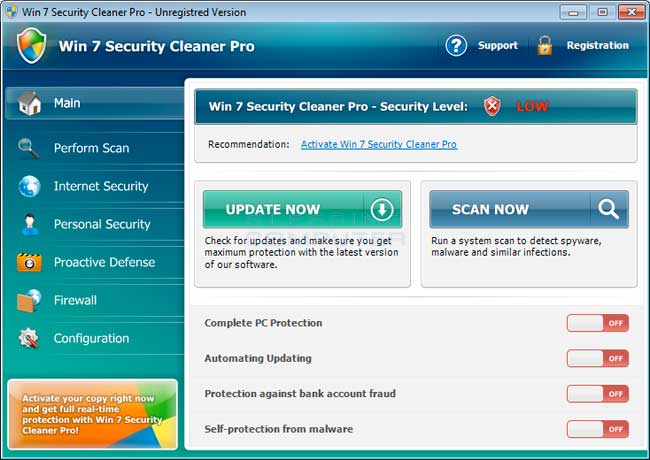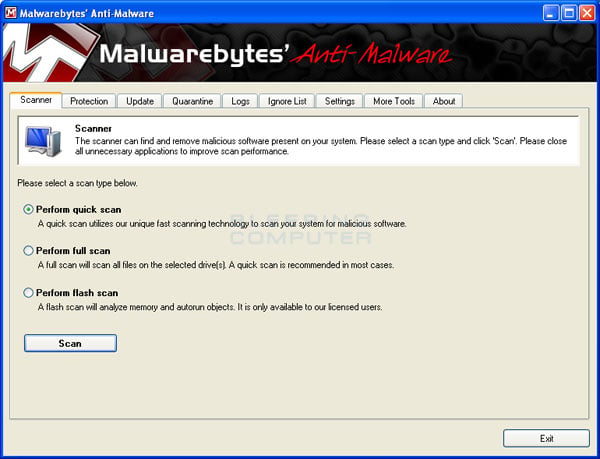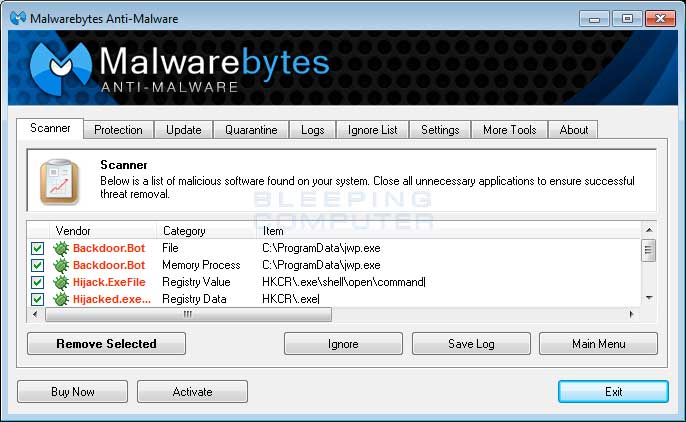Win 7 Security Cleaner Pro is a rogue anti-spyware program from the Rogue.FakeRean-Braviax family of computer infections. This infection is considered a rogue anti-spyware program because it purposely displays fake scan results, false security warnings, hijacks your web browser, and does not allow you to run your legitimate Windows applications. This scareware is promoted through web sites that have been hacked with scripts that try to install the software by exploiting vulnerabilities on your computer. It is also promoted through Trojans that pretend to be legitimate programs that are required to view an online video, but instead install the infection.

Win 7 Security Cleaner Pro Screen shot
For more screen shots of this infection click on the image above.
There are a total of 4 images you can view.
While the infection is started it will also show a variety of security warnings that are worded to think that your computer has a serious security issue. These alerts include:
System danger!
Your system security is in danger. Privacy threats detected. Spyware, keyloggers or Trojans may be working in the background right now. Perform an in-depth scan and removal now, click here.
System hijack!
System security threat was detected. Viruses and/or spyware may be damaging your system now. Prevent infection and data loss or stealing by running a free security scan.
Malware intrusion!
Sensitive areas of your system were found to be under attack. Spy software attack or virus infection possible. Prevent further damage or your private data will get stolen. Run an anit-spyware scan now. Click here to start.
Just like the scan results, these security alerts are fake and should be ignored. Finally, Win 7 Security Cleaner Pro will hijack your web browser so that you cannot visit web sites. When you attempt to visit a web site, you will instead be shown a page that states that the page you are visiting may be a security risk.
As you can see, this infection was created to scare you into thinking your computer has a security problem due to your computer being infected. Please do not purchase this program , and if you already have, please contact your credit card company and dispute the charges stating that the program is a computer infection and a scam. To remove Win 7 Security Cleaner Pro and related malware please use the guide below.
Threat Classification:
Advanced information:
View Win 7 Security Cleaner Pro files.
View Win 7 Security Cleaner Pro Registry Information.
Tools Needed for this fix:
Guide Updates:
04/19/13 - Initial guide creation.
- Print out these instructions as we may need to close every window that is open later in the fix.
- Reboot your computer into Safe Mode with Networking. To do this, turn your computer off and then back on and immediately when you see anything on the screen, start tapping the F8 key on your keyboard. Eventually you will be brought to a menu similar to the one below:

Using the arrow keys on your keyboard, select Safe Mode with Networking and press Enter on your keyboard. If you are having trouble entering safe mode, then please use the following tutorial: How to start Windows in Safe Mode
Windows will now boot into safe mode with networking and prompt you to login as a user. Please login as the same user you were previously logged in with in the normal Windows mode. Then proceed with the rest of the steps. - It is possible that the infection you are trying to remove will not allow you to download files on the infected computer. If this is the case, then you will need to download the files requested in this guide on another computer and then transfer them to the infected computer. You can transfer the files via a CD/DVD, external drive, or USB flash drive.
- Before we can do anything we must first end the processes that belong to Win 7 Security Cleaner Pro so that it does not interfere with the cleaning procedure. To do this, please download RKill to your desktop from the following link.
RKill Download Link - (Download page will open in a new tab or browser window.)
When at the download page, click on the Download Now button labeled Rkill.com. When you are prompted where to save it, please save it on your desktop. - Once it is downloaded, double-click on the Rkill.com icon in order to automatically attempt to stop any processes associated with Win 7 Security Cleaner Pro and other Rogue programs. Please be patient while the program looks for various malware programs and ends them. When it has finished, the black window will automatically close and you can continue with the next step. If you get a message that RKill is an infection, do not be concerned. This message is just a fake warning given by Win 7 Security Cleaner Pro when it terminates programs that may potentially remove it. If you run into these infections warnings that close RKill, a trick is to leave the warning on the screen and then run RKill again. By not closing the warning, this typically will allow you to bypass the malware trying to protect itself so that RKill can terminate Win 7 Security Cleaner Pro . So, please try running RKill until the malware is no longer running. You will then be able to proceed with the rest of the guide. Do not reboot your computer after running RKill as the malware programs will start again.
If you continue having problems running RKill, you can download the other renamed versions of RKill from the RKill download page. All of these files are renamed copies of RKill, which you can try instead. Please note that the download page will open in a new browser window or tab. - As this infection is known to be bundled with the TDSS/Necurs rootkit infection, you should also run a program that can be used to scan for this infection. Please follow the steps in the following guide:
How to remove Google Redirects or the TDSS, TDL3, or Alureon rootkit using TDSSKiller
If after running TDSSKiller, you are unable to update Malwarebytes' Anti-malware or continue to have Google search result redirects, then you should post a virus removal request using the steps in the following topic rather than continuing with this guide:Preparation Guide For Use Before Using Malware Removal Tools and Requesting Help Topic
If TDSSKiller requires you to reboot, please allow it to do so. After you reboot, reboot back into Safe Mode with Networking again. - Now you should download Malwarebytes Anti-Malware, or MBAM, from the following location and save it to your desktop:
Malwarebytes Anti-Malware Download Link (Download page will open in a new window) - Once downloaded, close all programs and Windows on your computer, including this one.
- Double-click on the icon on your desktop named mbam-setup.exe. This will start the installation of MBAM onto your computer.
- When the installation begins, keep following the prompts in order to continue with the installation process. Do not make any changes to default settings and when the program has finished installing, make sure you leave both the Update Malwarebytes Anti-Malware and Launch Malwarebytes Anti-Malware checked. Then click on the Finish button. If MalwareBytes' prompts you to reboot, please do not do so.
- MBAM will now automatically start and you will see a message stating that you should update the program before performing a scan. As MBAM will automatically update itself after the install, you can press the OK button to close that box and you will now be at the main program as shown below.

- On the Scanner tab, make sure the the Perform full scan option is selected and then click on the Scan button to start scanning your computer for Win 7 Security Cleaner Pro related files.
- MBAM will now start scanning your computer for malware. This process can take quite a while, so we suggest you go and do something else and periodically check on the status of the scan. When MBAM is scanning it will look like the image below.

- When the scan is finished a message box will appear as shown in the image below.You should click on the OK button to close the message box and continue with the Win 7 Security Cleaner Pro removal process.

- You will now be back at the main Scanner screen. At this point you should click on the Show Results button.
- A screen displaying all the malware that the program found will be shown as seen in the image below. Please note that the infections found may be different than what is shown in the image.

You should now click on the Remove Selected button to remove all the listed malware. MBAM will now delete all of the files and registry keys and add them to the programs quarantine. When removing the files, MBAM may require a reboot in order to remove some of them. If it displays a message stating that it needs to reboot, please allow it to do so. Once your computer has rebooted, and you are logged in, please continue with the rest of the steps. - When MBAM has finished removing the malware, it will open the scan log and display it in Notepad. Review the log as desired, and then close the Notepad window.
- You can now exit the MBAM program.
- As many rogues and other malware are installed through vulnerabilities found in out-dated and insecure programs, it is strongly suggested that you use Secunia PSI to scan for vulnerable programs on your computer. A tutorial on how to use Secunia PSI to scan for vulnerable programs can be found here:
How to detect vulnerable and out-dated programs using Secunia Personal Software Inspector
Your computer should now be free of the Win 7 Security Cleaner Pro program. If your current anti-virus solution let this infection through, you may want to consider purchasing the PRO version of Malwarebytes Anti-Malware to protect against these types of threats in the future.
If you are still having problems with your computer after completing these instructions, then please follow the steps outlined in the topic linked below:
Associated Win 7 Security Cleaner Pro Files:
%CommonAppData%\<random characters and numbers>
%LocalAppData%\<random characters and numbers>
%LocalAppData%\<random 3 characters>.exe
%Temp%\<random characters and numbers>
%AppData%\Roaming\Microsoft\Windows\Templates\<random characters and numbers>File Location Notes:
%Temp% refers to the Windows Temp folder. By default, this is C:\Windows\Temp for Windows 95/98/ME, C:\DOCUMENTS AND SETTINGS\<Current User>\LOCAL SETTINGS\Temp for Windows 2000/XP, and C:\Users\<Current User>\AppData\Local\Temp in Windows Vista, Windows 7, and Windows 8.
%CommonAppData% refers to the Application Data folder for the All Users Profile. By default, this is C:\Documents and Settings\All Users\Application Data for Windows 2000/XP and C:\ProgramData\ in Windows Vista, Windows 7, and Windows 8.
%AppData% refers to the current users Application Data folder. By default, this is C:\Documents and Settings\<Current User>\Application Data for Windows 2000/XP. For Windows Vista and Windows 7 it is C:\Users\<Current User>\AppData\Roaming.
%LocalAppData% refers to the current users Local settings Application Data folder. By default, this is C:\Documents and Settings\<Current User>\Local Settings\Application Data for Windows 2000/XP. For Windows Vista, Windows 7, and Windows 8 it is C:\Users\<Current User>\AppData\Local.
%CommonAppData% refers to the Application Data folder in the All Users profile. For Windows XP, Vista, NT, 2000 and 2003 it refers to C:\Documents and Settings\All Users\Application Data\, and for Windows Vista, Windows 7, and Windows 8 it is C:\ProgramData.
Associated Win 7 Security Cleaner Pro Windows Registry Information:
HKEY_CURRENT_USER\Software\Classes\.exe "(Default)" = '<random>'
HKEY_CURRENT_USER\Software\Classes\.exe\shell\open\command "(Default)" = "%LocalAppData%\<random 3 chars>.exe" -a "%1" %*
HKEY_CLASSES_ROOT\<random>
HKEY_CURRENT_USER\Software\Classes\<random> "(Default)" = 'Application'
HKEY_CURRENT_USER\Software\Classes\<random>\DefaultIcon "(Default)" = '%1'
HKEY_CURRENT_USER\Software\Classes\<random>\shell\open\command "(Default)" = "%LocalAppData%\<random 3 chars>.exe" -a "%1" %*
HKEY_CLASSES_ROOT\.exe\shell\open\command "(Default)" = "%LocalAppData%\<random 3 chars>.exe" -a "%1" %*
HKEY_CLASSES_ROOT\ah\shell\open\command "(Default)" = "%LocalAppData%\<random 3 chars>.exe" -a "%1" %*
HKEY_CLASSES_ROOT\ah\shell\open\command "IsolatedCommand"
HKEY_LOCAL_MACHINE\SOFTWARE\Clients\StartMenuInternet\FIREFOX.EXE\shell\open\command "(Default)" = ""%LocalAppData%\<random 3 chars>.exe -a "C:\Program Files\Mozilla Firefox\firefox.exe""
HKEY_LOCAL_MACHINE\SOFTWARE\Clients\StartMenuInternet\FIREFOX.EXE\shell\safemode\command "(Default)" = ""%LocalAppData%\<random 3 chars>.exe" -a "C:\Program Files\Mozilla Firefox\firefox.exe" -safe-mode"
HKEY_LOCAL_MACHINE\SOFTWARE\Clients\StartMenuInternet\IEXPLORE.EXE\shell\open\command "(Default)" = ""%LocalAppData%\<random 3 chars>.exe" -a "C:\Program Files\Internet Explorer\iexplore.exe""

No comments:
Post a Comment